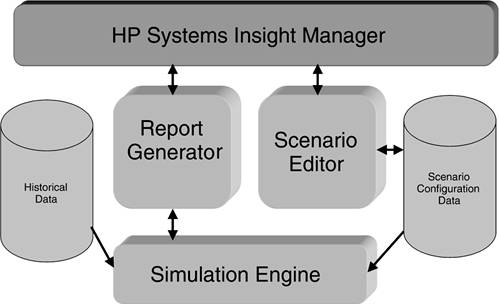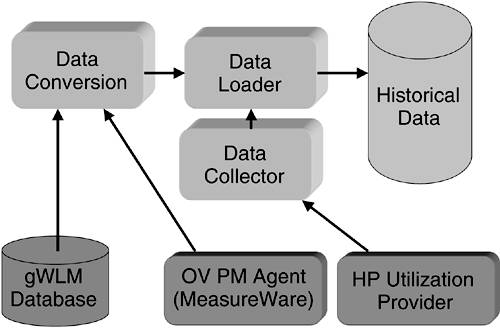Capacity Advisor
| Although many benefits can be gained from taking full advantage of virtualization and automation in the VSE, it tends to require specialized management tools. Capacity planning is a good example. The very dynamic nature of the VSE environment makes traditional capacity-planning tools ineffective. In response to this, HP has developed a capacity-planning tool called Capacity Advisor that is specifically designed to predict how the flexibility and automation inherent in the VSE will impact the running of your workloads. It can also be used to make recommendations on how to take advantage of some of these VSE technologies. note This section only provides an overview of the Capacity Advisor product. More details, and some usage examples, will be provided in Chapter 18, "Capacity Advisor." Capacity Planning in the VSEThe flexibility and automation available in the VSE pose some unique challenges. These include:
Let's explore these issues in a bit more detail before getting into how the Capacity Advisor tool deals with them. Flexible PartitionsA partition is an isolated environment in which you can run a workload without the fear that other workloads running on that server will impact it. Four different types of partitions are available on high-end HP platforms as part of the Virtual Server Environment. They each have unique flexing characteristics.
These are just a few examples of how a capacity-planning tool needs to adapt to the capabilities of the Virtual Server Environment. Utility Pricing SolutionsFor Capacity Advisor, the most interesting Utility Pricing technologies are Temporary Instant Capacity and Pay per use. Both of these allow you to allocate resources when a workload needs them. For the purposes of capacity planning, a tool needs to know if these resources are available and if there are business rules for when these resources can be activated. These will impact the ability of Capacity Advisor to simulate the use of these resources. gWLM AutomationThe fact that the flexing of resources in the VSE can be automated also impacts capacity planning. Capacity Advisor understands how gWLM policies are implemented and uses this information to adjust its simulations based on the policy that is defined. You can also have it rerun a simulation with a different policy to understand how the workload would have reacted if the other policy had been applied. Serviceguard FailoverSince workloads in a Serviceguard cluster can be manually or automatically migrated from one physical system to another, it is important that a capacity-planning tool know what systems and partitions each workload might be running in. This information will be important when determining what peak resources might be needed in case of a failover. Capacity Advisor FeaturesThe first release of Capacity Advisor will focus on a few key uses. These will be expanded over time, but it is important to get the infrastructure in place and solve the most compelling capacity-planning problems customers will have with the VSE. These are:
One of the unique features of the VSE is that workloads can be manually or automatically moved from one system to another. The goal of Capacity Advisor is to simulate the workload running on the other system so that before you initiate the move you can assess whether there will be resource contention issues. Another use for this is where you have a new workload and need to find a system in the infrastructure where it can run. Capacity Advisor will provide features to create a load profile based on data from a similar workload. You can then run a simulation to assess the impact of running this workload in a flexible partition on one or more systems in your existing infrastructure. Another nice feature of the VSE is the ability to reallocate resources between partitions and to allocate additional resources using Temporary Capacity or PPU. Capacity Advisor will allow you to simulate the impact of a change in the available resources in a partition or system. You can use this to determine if the change you are considering will result in any performance issues due to resource contention. The third item above is basic capacity planning. The tool will allow you to analyze historical resource consumption data and determine when or if you will run into resource contention issues with your workloads. The fourth item in the list above is the case where you are expecting a change in the load on an application and want to simulate what impact that change will have on the partition and system where the load is running. Capacity Advisor will allow you to adjust the data pattern. For example, if you are expecting to double the number of users for a particular application, you can run a simulation with the values for that application at double their historical rate. This will show if there will be any potential contention on the system. A number of core features are required to make these uses possible. These include:
The first item above is probably an obvious one. Capacity Advisor will allow you to collect data from several sources. It has its own data-collection mechanism in the VSE workload utilization WBEM provider. This is the same provider that the visualization and configuration management product uses to display real-time performance data in the big-picture views. However, Capacity Advisor pulls this data at configurable intervals and stores it in a database so it can do all the other things it does. In order to limit the amount of duplicate data that is being collected from your various systems, Capacity Advisor can also import data being collected by the OpenView Performance Agent. One nice feature of the utilization WBEM provider is that it allows you to define a workload as an arbitrary set of processes running on the system. That way if you have multiple applications running in a single partition, you can view each application's resource consumption independently. Graphing is another obvious requirement. You have collected all this data and you want to see what it looks like! Capacity Advisor will provide a large number of graphical reportseverything from a simple view of the data for a workload to the trending of the workload to the stacking of multiple workloads on a system or partition. The third item above is needed to allow you to simulate the addition of a new workload to a VSE-based system. You need to be able to create a "phantom" load that you would expect the new workload to look like so that you can assess what impact it will have on the system or systems you plan to run the new workload on. A variation on this is the ability to simulate the impact of an expected change to the load on an application. This will give you the ability to see the impact on a workload of the doubling of the number of users, for example. Capacity Advisor runs all of its reports and simulations based on what is called a "scenario." The best way to think of a scenario is that it is a collection of workload data and constraints that will be used to run simulations. An example would be that you want to move a workload to another system but aren't sure which system would be the best fit. The scenario would contain the data for the workload and the constraints for where that workload is allowed to run. Capacity Advisor can then show you what other systems or partitions meet the constraints and allow you to choose which one you want to simulate. The product will then run a simulation of what the resource consumption profile would be on the target system if you were to move the workload there. The last feature is important to ensure that any simulations you are running are based on appropriate data. Many workloads will experience abnormal resource consumption profiles at certain times. These may be due to special promotions, month-end processing patterns, or unexpected failovers, among other things. Therefore, you want to create a baseline profile for the application that allows you to exclude any abnormalities in the application's resource consumption. This can be used to detect when the workload is not behaving normally, or it could be used to ensure that you are basing future resource allocation decisions on "normal" usage patterns rather than idiosyncrasies. Capacity Advisor ArchitectureLike the other products in the VSE management suite, Capacity Advisor will have a component that runs on the central management server (CMS) and one that runs on the remote managed nodes. One difference, though, is that the agent running on the remote node is generally quite simple. This is because its only function is to collect data about the workloads running on each OS image. In fact, even the data collection is done on the CMS; the agent is simply providing access to the data from the network. Most of the functionality of this product is in how it allows you to use the data it collects. CMS ArchitectureThe architecture of the CMS portion of Capacity Advisor consists of a database, a user interface, a simulation engine, and both a scenario and a historical database. Figure 13-27 provides a high level view of this architecture. Figure 13-27. The Architecture of the CMS Portion of Capacity Advisor
The user interacts with Capacity Advisor through the Systems Insight Manager interface. The user interface portions of Capacity Advisor consist of a scenario editor, which you use to define the constraints for the simulations you want to run, and the report generator, which takes the output of the simulation engine and provides a human-readable report. Data Collection ArchitectureCapacity advisor needs data. There are two ways to get data into the database and there will be more in future releases. The current options are:
The first item is where Capacity Advisor will collect data on your behalf from the utilization WBEM provider that is available on the remote partitions. Another common data source for HP customers is the OpenView Performance Agent. This tool collects a tremendous amount of data for performance analysis and troubleshooting. Capacity Advisor needs only a small subset of this data. Therefore, it provides a utility that will allow you to pull this data into the Capacity Advisor database. A future release will allow gWLM to use resource consumption data. This will be an important integration point for the VSE Management suite: data collected by one tool will be available to other tools. Figure 13-28 provides an architectural view of the data-collection infrastructure of Capacity Advisor. Figure 13-28. Architecture of the CMS Portion of Capacity Advisor
The data loader portion of this architecture is used by all the collection mechanisms. This is a reusable component that can be used to collect data from virtually any source and get it into Capacity Advisor database. You notice though, that the data does need to be cleaned up and converted into the correct format before the loader will accept it. |
EAN: 2147483647
Pages: 197

